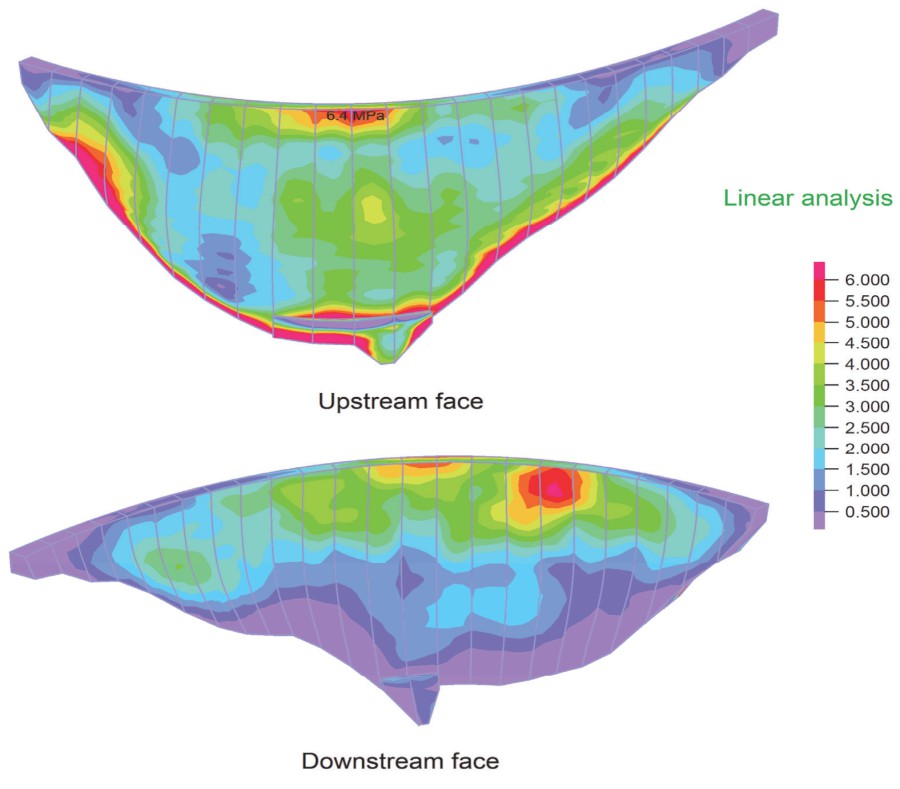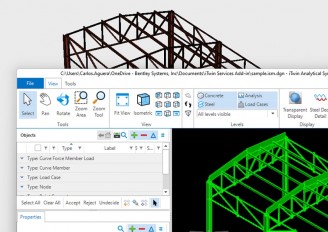
Ensuring the safety of dams during earthquakes is crucial since seismic forces can lead to various damages, e.g. cracking, displacement, or detachment of dam components. These damages can result in uncontrolled water release or devastating floods. Finite element analysis is a key numerical method employed to assess the possible seismic damage and thus it plays a vital role in evaluating the structural response of dams subjected to seismic forces. In this blog post, we highlight a case study conducted by a team of engineers in Switzerland who utilized ADINA, a powerful engineering software, to assess the seismic safety of the Gigerwald dam.
The roof being discussed is a large steel structure with a wide span, as depicted in Figure 1. In the center of the structure, there is a circular dome measuring 80m in diameter and 16m in height. The rim of the dome is supported by transitional trusses that connect it to the surrounding structure. The circled zone on the dome's rim represents the specific area of interest, where laboratory tests were conducted and results obtained. Please refer to Figures 2 and 3 for more details on these test results.

The Gigerwald dam, located in the Canton of St. Gallen, Switzerland, is an arch dam standing at a height of 147m. It consists of 24 vertical monoliths made of concrete, designed to withstand compression forces induced by water pressure and self-weight, preventing their separation. Swiss regulations mandated that the dam should withstand an earthquake of 8.0 MSK intensity at its location, with a return period of 10,000 years, without uncontrolled water release. To meet these requirements, the design team employed ADINA's linear and nonlinear dynamic analysis capabilities, considering block-to-block contact, to evaluate the dam's performance and the tightness between its components during a seismic event of such magnitude.
The ADINA model of the dam was constructed, incorporating seismic shaking through acceleration loading. The seismic load was applied simultaneously with the self-weight of the dam and the water pressure exerted by the reservoir on the upstream side. These factors were considered together in the analysis to accurately simulate the real-world conditions and understand the dam's response. The dynamic analysis also accounted for hydrodynamic effects.


To assess the potential safety threat posed by separation between blocks, a nonlinear dynamic analysis was conducted. Contact was defined between the touching faces of adjacent monoliths. The analysis revealed that the maximum separation and sliding displacements would occur at the crest level of the dam. The observed separations were in the range of a few millimeters (mm), as depicted in Figure 4 and Figure 5.


When block separation occurs at the crest level, the arch-dam's compressive effect is lost, and some monoliths may act as cantilevers over a free vertical length at their top. This situation could lead to complete detachment of the upper portion of a monolith due to fracture if the earthquake-induced horizontal forces exceed certain thresholds. To evaluate this possibility, engineers employed a 3D model with pre-existing horizontal cracks informed by previous analyses. The results indicated that the final crack opening and the movement of the detached portion remained within safety margins. For example, at a crack location assumed to be 27m below the crest level (where the highest vertical tensile stress occurs), the crack opening measured 6mm.

Based on the extensive analyses conducted, the engineers concluded that the Gigerwald dam would withstand an earthquake of the specified magnitude, as mandated by local authorities, ensuring its safety. Furthermore, this application demonstrates some of the powerful capabilities of ADINA, making it an ideal tool for solving complex structural problems. Notably, it enables seamless transition from linear analysis to complex nonlinear analysis, including contact, using the same finite element discretization.
Source: Bentley Virtuosity Blog
Want to read more like this story?

40 years after Kelly Barnes dam failure
Nov, 06, 2017 | NewsOn this day in 1977, a small embankment dam located above Toccoa Falls Bible College in Georgia fail...

Bentley Webinar | Direct Analysis and Stability Analysis of Steel Structures per AISC Code
Sep, 15, 2023 | EventThe Direct Analysis Method (DAM) is a cutting-edge approach for designing steel structures, as pe...

Disneyland may be threatened by potential failure of a local dam
Jun, 03, 2019 | NewsAccording to federal engineers, Disneyland may be in danger as a local dam could fail if an intense...
ADAP-88
Dec, 06, 2013 | Software
Safety works to initiate at California's Boca Dam
Apr, 12, 2019 | NewsOfficials from the U.S. Department of Interior's Bureau of Reclamation have decided to implement saf...

Domed roof analysis of a railway station
Apr, 28, 2023 | NewsSouthwest Jiaotong University studied the structural integrity of the roof of a huge railway statio...

How advanced finite element analysis can prepare buildings for extreme events
Nov, 14, 2024 | NewsWhile most structural analysis software can evaluate everyday stresses, they often fail to prepare...

Frequency Response Analysis with DIANA
Nov, 14, 2013 | NewsThe dynamic analysis of dam-fluid-foundation interaction is of vital importance in engineering pract...

Hayward Baker will be at " Dam Safety 2017 "
Aug, 24, 2017 | NewsCome and visit Hayward Baker at Dam Safety 2017 at J.W. Marriott San Antonio Hill Country, San Anton...
Form
Looking for more information? Fill in the form and we will contact Bentley for you.
Trending

Spectacular interchanges around the world

New Release - STAAD.Pro 2024 - 2

ADINA 2025 for Structural WorkSuite

ADINA 2025 New Release!

Concrete Buildings as Rechargeable Batteries

Powerful earthquake shakes central Philippines, dozens killed


